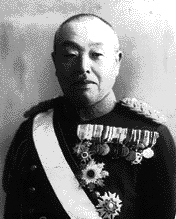Jōtarō Watanabe facts for kids
Quick facts for kids
Jōtarō Watanabe
|
|
|---|---|

General Watanabe Jōtarō
|
|
| Native name |
渡辺 錠太郎
|
| Born | April 16, 1874 Komaki, Aichi, Japan |
| Died | February 26, 1936 (aged 61) Tokyo, Japan |
| Allegiance | |
| Service/ |
|
| Years of service | 1895–1936 |
| Rank | |
| Commands held | 7th Division Taiwan Army Inspector General of Military Training |
| Battles/wars | Russo-Japanese War |
Jōtarō Watanabe (渡辺 錠太郎, Watanabe Jōtarō, April 16, 1874 – February 26, 1936) was an important general in the Japanese Army during the early Shōwa period. He is known as one of the people who died during the February 26 Incident, a major event in Japanese history.
Contents
Life and Career
Early Life and Military Training
Jōtarō Watanabe was born in Komaki, Aichi, Japan. His family faced tough times when his father's business failed. Because of this, young Jōtarō had to leave middle school. At age 19, he was adopted by a farmer named Watanabe Shobei and took his new family name.
When he was 20, he joined the Imperial Japanese Army Academy. He worked hard and graduated in June 1897, becoming an officer cadet. After graduating, he was assigned to the IJA 19th Infantry Regiment. He was promoted to lieutenant in November 1899.
In December 1900, he entered the Army Staff College. He finished at the top of his class in December 1903. He was then promoted to captain and became a squad leader. He joined the IJA 36th Infantry Regiment in Manchuria during the Russo-Japanese War (1904-1905).
Rising Through the Ranks
After the war, Watanabe was moved to the Imperial General Headquarters. The next year, he became an aide to General Yamagata Aritomo. He traveled as a military expert to China in 1906 and Germany in 1907. He was promoted to major in December 1908.
Watanabe returned to Germany from May 1909 to June 1910. He worked at the Japanese embassy in Berlin. When he came back to Tokyo, he joined the Imperial Japanese Army General Staff. In November 1910, Field Marshal Yamagata asked for Watanabe to be his aide again. Watanabe served Yamagata until February 1915. During this time, he became a lieutenant colonel in June 1913.
In February 1915, after World War I began, Watanabe was assigned to the IJA 3rd Infantry Regiment. He moved back to the General Staff in May 1916. In July of that year, he was promoted to colonel. In October 1917, he became a military expert at the Japanese embassy in Brussels, Belgium. There, he learned about the effects of modern, mechanized warfare.
Becoming a General
In August 1920, Watanabe was promoted to major general. He took command of the IJA 29th Infantry Brigade. He returned to the General Staff in September 1922 as the Head of the 4th Bureau. In May 1925, Watanabe became a lieutenant general. He also became the leader of the Army Staff College.
In May 1926, he commanded the IJA 7th Division. From March 1929, he led the Imperial Japanese Army Air Force. From June 1930, he was the commander of the Taiwan Army.
In August 1931, Watanabe was called back to Tokyo. He was promoted to full general. He also became a military advisor, watching over Army aviation.
Inspector General and His Death
In July 1935, General Watanabe received a very important job. He became the Inspectorate General of Military Training. This was one of the most respected positions in the Imperial Japanese Army. He replaced Jinzaburō Masaki.
Masaki was a close friend of General Sadao Araki and his group, the Imperial Way Faction. This group believed in strong military rule and expanding Japan's power. General Watanabe, however, was known for being more moderate. Many young officers who later rebelled respected Masaki. They blamed Watanabe for Masaki losing his job.
When Watanabe took his new role, he held a press conference. He said that the Army should be controlled by the Army Ministry. This meant he supported civilian leaders having control over the military. This idea made the Imperial Way Faction very angry.
General Watanabe was the only active military person on the rebels' target list. During the February 26 Incident, rebel soldiers surprised Watanabe at his home in Ogikubo. They shot him, and he died in front of his wife and daughter. His grave is in Tama Cemetery in Tokyo. His daughter, Kazuko, later became a Catholic nun.
After his death, Watanabe was given special honors. He received the Order of the Rising Sun with Paulownia Flowers. He was also given the honorific title of Junior Second Court Rank.
Decorations
- 1934 –
 Order of the Golden Kite, 5th class
Order of the Golden Kite, 5th class - 1934 –
 Grand Cordon of the Order of the Rising Sun
Grand Cordon of the Order of the Rising Sun - 1936 –
 Order of the Rising Sun with Paulownia Flowers
Order of the Rising Sun with Paulownia Flowers

